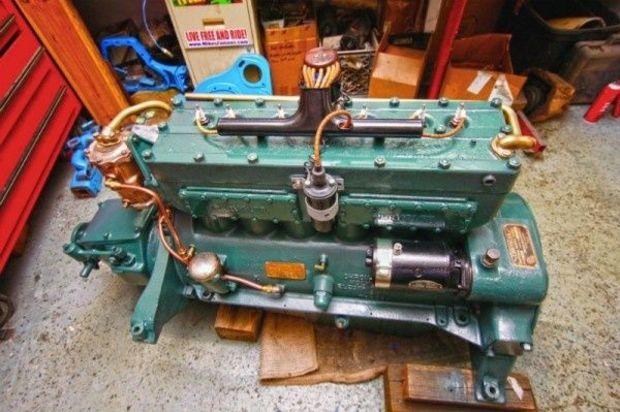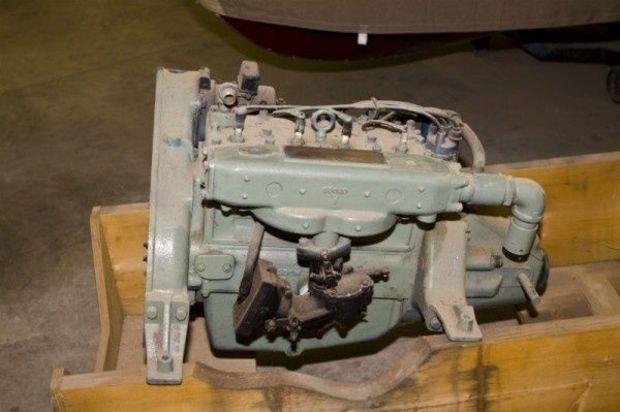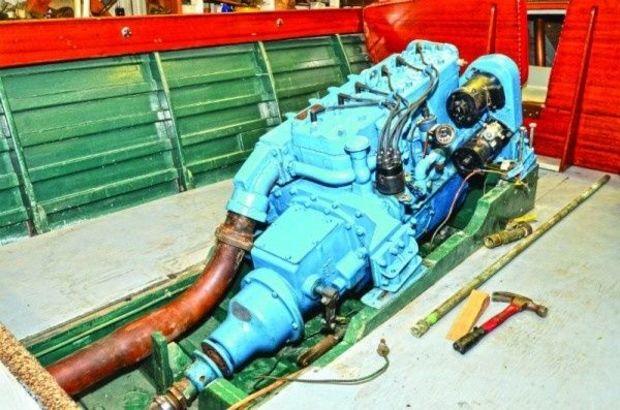Story by Gary Reich
Saving and old, classic, wooden powerboat from the dumpster is a complex operation. First you have to actually save and restore the boat itself, making sure she’s safe to use on the water and protected from further rot and damage. If you’re interested in the process behind making that happen, turn to page 54 for the scoop. But what’s the drill when you have an old, rusted block of metal that looks more like a relic from Fred Sanford’s junk yard than an eye-popping, horsepower-producing machine? Since Jerry LeCompte of Dockside Boat Works in Easton, MD, loves old engines, we asked him. For gear heads, there aren’t many other sights that cause salivation more readily than a shiny, restored engine that looks as if it just came from the factory. And depending on your level of anal-retentiveness, you can shoot for that original glory benchmark—warning stickers, bright copper tubing work, and all—or just preserve it and get it running and safe again. As usual when dealing with boats, though, the thickness of your wallet and overall budget will be your best guides. LeCompte says, “Lots of owners feel comfortable working on the restoration aspects of their boats, but come to me when they want engine work done. We do everything from just getting an engine running to restoring it back to original condition.” When you talk about old inboard boat engines, you’ll hear name such as Chris-Craft, Graymarine, Interceptor, and Chrysler. “There aren’t very many old boat engines that were purpose-built as boat engines,” LeCompte says, adding, “Graymarine used Continental and some American Motors blocks, Chris-Craft made its engines from Hercules parts, Interceptor used Ford blocks, and all sorts of companies used General Motors blocks. Chrysler did have some purpose-built boat engines in the older models, but most of their stuff was marinized from automobile engines just like the others. Packards came from Rolls-Royce Merlin blocks. Not that it makes much difference, but since some of these engines have automobile DNA, that helps in finding parts sometimes, especially with the General Motors blocks.” So what are some of the challenges you might encounter when taking on an engine restoration? According to LeCompte, finding parts is near the top of the challenge list. He says, “I can get a generator or alternator rebuilt at a number of local places, and there are all sorts of machine shops and other outfits that I can use for other parts, but if I can’t find a set of valves for a rare engine, things get challenging.” LeCompte went on to tell me about a recent rebuild he completed that had three bad valves. When he couldn’t’ find a parts engine to get them from, he had to get creative. “I started calling around and finally got hold of a guy in Florida who knew just about everything when it comes to Chris-Craft engines. He told me that the valves were almost impossible to get, but that if I could find the valves from one particular model of Detroit Diesel, I could have them machined to fit that old Chris-Craft power plant. Those are the sorts of things we have to sometimes.”
Parts acquisition aside, LeCompte explains that restoring an old engine generally requires pulling it apart, servicing and cleaning all of its components such as carburetors, generators, water pumps, distributor, heads, and manifolds; and then cleaning, rebuilding, and refinishing everything. He says, “Smaller parts can be bead or material blasted here in the shop to remove corrosion or old finishes. If we have a larger engine component such as block or heads that need stripping, we can send it to get a soak in a hot bath, which removes just about everything. We can sleeve cylinder walls that are worn, and we make sure all of the inner parts such as crankshaft, rods, pistons, rings, and valve train components are rebuilt or replaced before we put the whole engine back together. Then we paint the engine, attach all of the rebuilt and refinished components, and fit it inside the boat. Last, we work on getting all the old controls, fuel lines, electrical components, shaft, and exhaust hooked up and working.”
Smaller components such as carburetors, generators or alternators, water pumps, and transmissions can be serviced individually by shops that specialize in those parts, but LeCompte says that much of that work can be done in-house. He says, “I usually send out generators and alternators to be rebuilt by a local company. I don’t have the gear her to do it, and it’s not ridiculously expensive to get that done outside. I have machine shops do lots of fabrication work for me, especially cooling and exhaust components, and I have loads of other shops that specialize in various bits and pieces to get the small details finished. There’s even a guy I use who can replicate some of the old warning stickers found on these engines.”
So what are some of the challenges you might encounter when taking on an engine restoration? According to LeCompte, finding parts is near the top of the challenge list. He says, “I can get a generator or alternator rebuilt at a number of local places, and there are all sorts of machine shops and other outfits that I can use for other parts, but if I can’t find a set of valves for a rare engine, things get challenging.” LeCompte went on to tell me about a recent rebuild he completed that had three bad valves. When he couldn’t’ find a parts engine to get them from, he had to get creative. “I started calling around and finally got hold of a guy in Florida who knew just about everything when it comes to Chris-Craft engines. He told me that the valves were almost impossible to get, but that if I could find the valves from one particular model of Detroit Diesel, I could have them machined to fit that old Chris-Craft power plant. Those are the sorts of things we have to sometimes.”
Parts acquisition aside, LeCompte explains that restoring an old engine generally requires pulling it apart, servicing and cleaning all of its components such as carburetors, generators, water pumps, distributor, heads, and manifolds; and then cleaning, rebuilding, and refinishing everything. He says, “Smaller parts can be bead or material blasted here in the shop to remove corrosion or old finishes. If we have a larger engine component such as block or heads that need stripping, we can send it to get a soak in a hot bath, which removes just about everything. We can sleeve cylinder walls that are worn, and we make sure all of the inner parts such as crankshaft, rods, pistons, rings, and valve train components are rebuilt or replaced before we put the whole engine back together. Then we paint the engine, attach all of the rebuilt and refinished components, and fit it inside the boat. Last, we work on getting all the old controls, fuel lines, electrical components, shaft, and exhaust hooked up and working.”
Smaller components such as carburetors, generators or alternators, water pumps, and transmissions can be serviced individually by shops that specialize in those parts, but LeCompte says that much of that work can be done in-house. He says, “I usually send out generators and alternators to be rebuilt by a local company. I don’t have the gear her to do it, and it’s not ridiculously expensive to get that done outside. I have machine shops do lots of fabrication work for me, especially cooling and exhaust components, and I have loads of other shops that specialize in various bits and pieces to get the small details finished. There’s even a guy I use who can replicate some of the old warning stickers found on these engines.”
 When I asked him if there’s anything that can’t be done to get an old engine running or restored, LeCompte seems to think it’s only a matter of how deep your pockets are, saying, “We can have new pistons made, crankshafts manufactured… there’s not many things we can’t have made for a price. I suppose if a block was cracked beyond repair and it was the last one on the planet that we might have trouble, but again, there’s little that we can’t do.” LeCompte says, “An engine doesn’t have to be completely torn down and put together again to be functional and usable, but those are usually the type of engine jobs I do. The folks I deal with are usually trying to get the boat back to its original condition, and the details are important if they want to enter the boat for judging at classic boat shows.”
And the cost? Well, that depends, of course, and a rebuild or restoration can run anywhere from a couple of thousand dollars upwards to tens of thousands depending on what needs to be done. Realistic restorers go into a rebuild knowing that there likely will be expensive surprises at some point during the rebuild—it’s part of the game.
So why do it? LeCompte says, “Because it’s part of bringing back a piece of history, and that’s satisfying.
When I asked him if there’s anything that can’t be done to get an old engine running or restored, LeCompte seems to think it’s only a matter of how deep your pockets are, saying, “We can have new pistons made, crankshafts manufactured… there’s not many things we can’t have made for a price. I suppose if a block was cracked beyond repair and it was the last one on the planet that we might have trouble, but again, there’s little that we can’t do.” LeCompte says, “An engine doesn’t have to be completely torn down and put together again to be functional and usable, but those are usually the type of engine jobs I do. The folks I deal with are usually trying to get the boat back to its original condition, and the details are important if they want to enter the boat for judging at classic boat shows.”
And the cost? Well, that depends, of course, and a rebuild or restoration can run anywhere from a couple of thousand dollars upwards to tens of thousands depending on what needs to be done. Realistic restorers go into a rebuild knowing that there likely will be expensive surprises at some point during the rebuild—it’s part of the game.
So why do it? LeCompte says, “Because it’s part of bringing back a piece of history, and that’s satisfying.